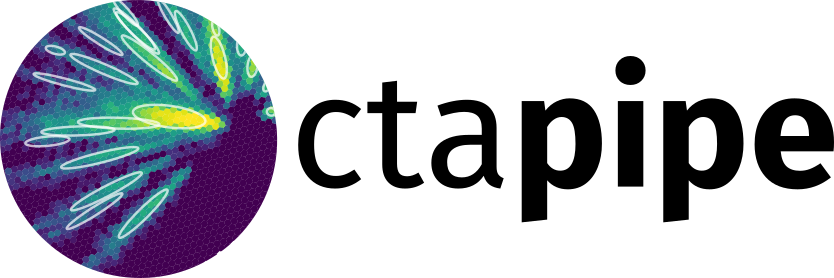Histogram#
- class ctapipe.utils.Histogram(nbins, ranges, name='Histogram', axis_names=None)[source]#
Bases:
objectAn N-D histogram class with FITS image I/O.
The output FITS file will contain an ImageHDU datacube and associated WCS headers to describe the axes of the histogram. Thus, the output files should work correctly in any program capable of working with FITS datacubes (like SAOImage DS9).
Internally, it uses
numpy.histogramddto generate the histograms.All axes are assumed to be linear, with equally spaced bins (otherwise they could not be stored in a FITS image HDU)
- Attributes:
- data: np.ndarray
the histogram counts.
- nbins: array_like(int)
list of number of bins for each dimension
- ranges: list(tuple)
list of (min,max) values for each dimension
- name: str
name of histogram (will be used as FITS extension name when written to a file
- axis_names: list(str)
name of each axis
Examples
>>> hist = Histogram(nbins=(10,10), ranges=[[-1,1], [-1,1]]) >>> data = np.random.normal(size=(100, 2)) # make 100 random 2D events >>> hist.fill(data)
Get a point in the histogram (can also get multiple values at once by passing an array)
>>> val = hist.get_value([0.1,-0.5]) >>> vals = hist.get_value([[0.1,-0.5], [0.9,0.9]])
Get the full data array and do things with it:
>>> meanx = hist.data.mean(axis=0)
Write it to a FITS image file:
>>> hist.to_fits().writeto("output.fits")
Read it from FITS image file:
>>> hist2 = Histogram.from_fits("output.fits")
Attributes Summary
lower edges of bins.
for backward compatibility.
returns the number of outlier points (the number of input datapoints - the sum of the histogram).
Methods Summary
bin_centers(index)returns array of bin centers for the given index
draw_1d([dim])draw_2d([dims])draw the histogram using pcolormesh() (only works for 2D histograms currently)
fill(datapoints, **kwargs)generate a histogram from data points.
from_fits(input_fits)Construct a
Histogramfrom a previously written FITS histogram file or HDU (seeHistogram.to_fits())get_value(coords[, outlier_value])Returns the values of the histogram at the given world coordinate(s)
resample_inplace(nbins)Change the shape of the histogram using an n-dimensional interpolation function (via
ndimage.map_coordinates).to_fits()Convert the
Histograminto anastropy.io.fits.ImageHDU, suitable for writing to a file.Attributes Documentation
- bin_lower_edges#
lower edges of bins. The length of the array will be nbins+1, since the final edge of the last bin is included for ease of use in vector operations
- bins#
- hist#
for backward compatibility. Use
Histogram.datafor read/write access
- ndims#
- outliers#
returns the number of outlier points (the number of input datapoints - the sum of the histogram). This assumes the data of the histogram is unmodified (and represents “counts”).
- ranges#
Methods Documentation
- draw_2d(dims=(0, 1), **kwargs)[source]#
draw the histogram using pcolormesh() (only works for 2D histograms currently)
- Parameters:
- dims: (int,int)
indices of which dimensions to draw
- kwargs:
arguments to pass to matplotlib
pcolormeshcommand
- fill(datapoints, **kwargs)[source]#
generate a histogram from data points. Since the results of fill() are added to the current histogram, you can call fill() multiple times to fill a single Histogram.
- Parameters:
- datapoints: array_like
array of N-d points (see
numpy.histogramdddocumentation)- kwargs:
any extra options to pass to
numpy.histogramddwhen creating the histogram
- classmethod from_fits(input_fits)[source]#
Construct a
Histogramfrom a previously written FITS histogram file or HDU (seeHistogram.to_fits())- Parameters:
- input_fits: string or astropy.io.fits.ImageHDU
File or HDU to read into histogram (Should be a FITS HDU originally created by
Histogram.to_fits(), may not work for general FITS images)
- get_value(coords, outlier_value=None)[source]#
Returns the values of the histogram at the given world coordinate(s)
- Parameters:
- coords: array_like
array of M coordinates of dimension N (where the N is the histogram dimension)
- outlier_value: float or None
value for outliers, if None, coordinates outside the edges of the histogram will be given the edge value
- resample_inplace(nbins)[source]#
Change the shape of the histogram using an n-dimensional interpolation function (via
ndimage.map_coordinates).- Parameters:
- nbins: tuple of int
a tuple of the new number of bins to resample_inplace this histogram over (e.g. if the original histogram was (100,100), setting bins to (200,200) would provide double the resolution, with the interviening bins interpolated.
- to_fits()[source]#
Convert the
Histograminto anastropy.io.fits.ImageHDU, suitable for writing to a file.

